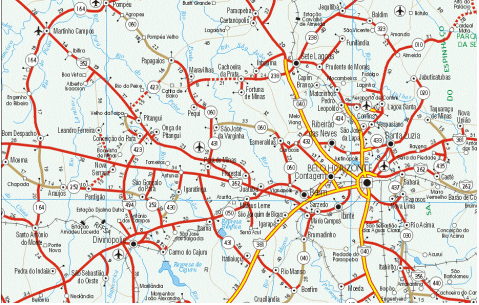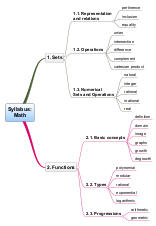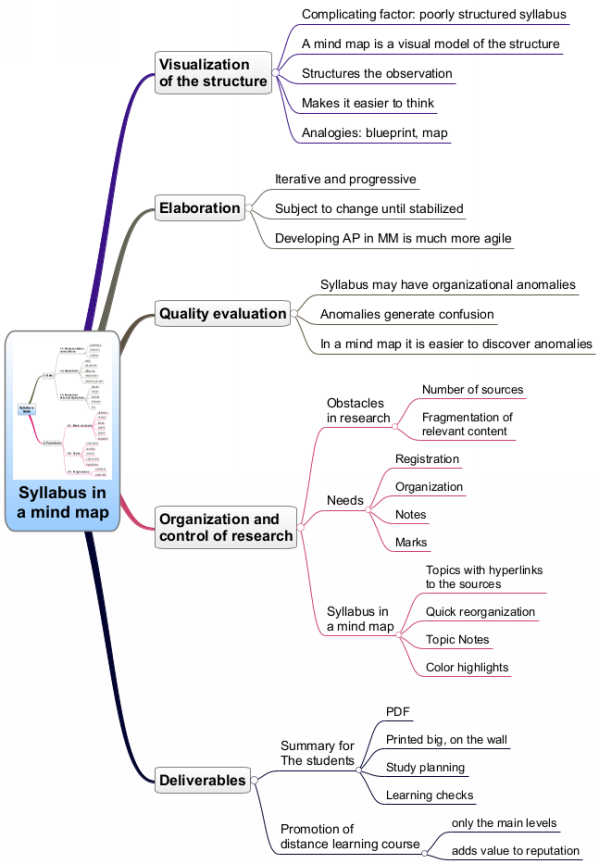While putting together courses, I used mind maps for various interesting purposes; In particular, a mind map of the syllabus has been very useful. In this article I describe several possibilities of using mind maps to work on a syllabus, which can bring more comfort, quality and productivity to this task that is so important when planning the teaching-learning process.
At the end you will find a summary with the relevant ideas for you to apply the content, in the form of an image and a PDF.
Mind maps and visualization of the structure of the syllabus
Recording and organizing search results
Syllabus mind map as a deliverable
Structure visualization
Consider this math syllabus:
Syllabus – Mathematics (partial)
1. Sets
1.1. Representation and relations: membership, inclusion and equality.
1.2. Sets: Operations of union, intersection, difference, complement and Cartesian product.
1.3. Number Sets and Operations: Natural, Integer, Rational, Irrational and Real.
2. Functions
2.1. Definition of function, domain, image, graphs, increase, and decrease.
2.2. Functions: polynomial, absolute value, rational, exponential and logarithmic.
2.3. Sequences: Arithmetic Progressions and Geometric Progressions.
Now see a representation of this same syllabus in a mind map (with a few adjustments in the organization):

Which do you think is more productive, as it is faster to understand? I think you'll agree that it's in the form of a mind map; if not, you have mastered some special thinking skill that is out of the ordinary.
And why is it more productive in the format of a mind map? The explanation uses the way our thinking works and its relationship with perception, more specifically observation.
Imagine that you are wanting to build a house. One of the things you do first, if you haven’t outsourced the project, is to sketch out the structure of the house, in the form of a floor plan.

You will have to talk to someone about this plan, either with the others who will live in the house, or who will build it. What would it be like to talk about the house without the plan? You can check this by trying to describe your current residence only using words; you will be able to give information about the structure, such as how many and what rooms there are, but when you get to the details of their areas and distribution, you will have difficulties and may not even be successful.
Plans and maps play an important role in representing information - they visually reveal structure. In other words, they constitute visual models of the structure of some object or territory.
A visual model of the structure plays a key role in our intelligence: it guides perception. For example, when looking at a house plan, we identify the rooms and then we can focus on one room at a time. From this structure, we can apply the divide-and-conquer principle (I prefer to treat it as structure-to-conquer) and it is much easier to maintain concentration due to the visual support.
Once we have a structure, we can think about each of its components. For example, what will the room be like, what furniture and decoration will it have? In fact, the structure is the basis for all the planning for structuring the property and consequently the budget.
In another context, how would we manage without road maps? What if we had the highways and cities described only in common language, that is, prose?

By looking at a road map, we can quickly find out which cities exist, where they are, and what the possible paths are between them. A map quickly tells us what exists in a territory.
A visual model of the structure guides observation and thought.
The figure that represents the model of the structure can be on paper, on the canvas, or in thought. If we have it memorized, we don't need external support, which we otherwise use to reactivate forgotten information. And by memorizing, thinking about the structure can also be much faster.
A visual model of the structure guides memorization and recall.
Mind maps and visualization of the structure of the syllabus
When we observe a syllabus that doesn’t show its structure or shows it only partially, as in the example list shown previously, the complicating factor is that we have to identify this structure for ourselves and stabilize it in the mind without external support.
The same syllabus in mind map form shows the structure visually, even if reduced so that the text cannot be read, as in the next figure.

By visualizing the structure of the syllabus, then, as in the case of a house plant, we can quickly identify each individual element and think about it, either by evaluating or by making decisions, while maintaining its relationship to the element above, which provides it within context, and its position in the whole.
Elaboration
A teacher may receive a pre-prepared syllabus, may have to prepare it from scratch or even receive a syllabus that must be fleshed-out. Here we consider the case where you need to assemble the syllabus yourself.
In my experience, developing a non-trivial syllabus is not a linear process, but a progressive one: we go through it several times in iterations (cycles), each iteration adds, changes, and remove topics, and it changes its organization multiple times. When we are planning lessons, sometimes we discover a sequence problem or omission or we still think it is worth inserting something, and we have to go back to the syllabus (changing the scope - tough!). A mathematical form that illustrates this iterative and progressive process very well is the spiral.

In this type of scenario, it becomes very important to have a good visualization of the overall structure, to better see the whole, the underlying structure and dependencies, and also be able to quickly edit the changes.
That's why all the syllabus I've made for a long time have been edited in a mind map made in an app. I have already mentioned the visualization aspect of the structure; Editing, on the other hand, is very fast: moving topics requires a single mouse gesture, for example.
Quality assessment
Take a look at the following Biology syllabus mind map of an old admission test for a university.

Note that there are two repetitions in different branches, Virus/Associated traits... and Microorganisms/Ecological Importance (in brighter yellow). There may be some reason for the repetition, but it is most likely an inconsistency.
These repetitions may in fact constitute organizational anomalies. Organizational anomalies generate disorder in the relationships between the elements of the syllabus, whose effect on the reader is confusion, as opposed to clarity, and any planning that uses this syllabus will also be impaired.

When you plan these parts, you will have to deal with the anomalies that you may encounter. If you have to tinker a lot, making changes to a mind map will be very productive. This still depends on the usability provided by the app, but overall it adds value.
By the way, note that these quality issues were found by a complete layman in the content in question (myself), and the visualization of the structure provided by the mind map helped a lot.
Recording and organizing search results
Ideally, when you prepare a course, you would use a single didactic material and source. In practice, you will have multiple sources, some more useful, others with only a few relevant passages. There are several possible types of sources in terms of the information they contain and what to do with them:
- Sources that have been discovered but not explored.
- Digital sources will have hyperlinks to your files or pages.
- Notes, such as reminders and things to do.
- Control markers, such as completed, in progress, and not yet worked on.
The syllabus mind map can be used as a basis for organizing and controlling your research:
- If there is a hyperlink, it is inserted into the very topic to which it refers; if there is more than one, they are inserted as subtopics.
- Small notes can be inserted as subtopics; larger notes, as topic notes.
- Colors can indicate progress, such as green for those already processed, blue for those in progress and no color for those that are yet to be evaluated.
I've done a lot of research and sometimes I use a mind map, sometimes I use Word, the decisions are made case-by-case. The navigation pane of the most recent versions of Word has made it much easier to work on the structure of the content, and made things that I could only do before on a mind map more practical. There have also been cases where I started in Word and then switched to a mind map, as well as the other way around.
I believe that for you, the decision will also be made case-by-case, sometimes based on experience; there are things that seem great in theory, but digging deeper and gaining experience are what is really going to reveal what is best.
Syllabus mind map as a deliverable
The syllabus is an artifact with the interesting characteristic of being both an internal information product (for work), and a deliverable for others. The traditional use is in official documents, such as in the Course Plan; let's look at other possible uses of a syllabus's mind map as a deliverable.
Summary for students
You can give students the mind map of the syllabus, which they can use in a variety of ways.
A piece of content can be more or less active in the mind; sometimes we refer to it as the information being present. Students can use the syllabus to quickly reactivate what they have already worked on in relation to the course.
Students can also use the syllabus to check their learnings, testing what they know for each topic. The difficulties they have will be input for dedication planning. A check can also be used to recognize progress already made; something useful for those who are focused on the empty half of the cup and thus not valuing what they have already achieved.
A very usable digital format of a mind map is in a PDF file, with a page size that allows the entire mind map to fit on a single page. Visually, there are no divisions in this case. As of version 2.0, EasyMapper generates such a PDF with a single command.
In certain circumstances and when possible, I prefer a printed mind map, because it allows a complete view of the whole in the same visual field. Something I would consider would be to provide a printed syllabus for the students. Good mind mapping programs allow for scaling; I would also consider printing a large version to post on the wall, a poster, where it can be seen many times and be used to indicate some topic without having the digital image of it. This option was used twice in a cultural fair, told on this page.

Promoting a distance learning course
If you are going to offer a distance learning course, you will have to advertise it, which usually includes its syllabus. This disclosure can be done with the image of the mind map, possibly adding value to your authority as a teacher (depending on how it is done, of course).
In my case, I consider that I do not need to disclose the complete syllabus; it adds nothing to prospective students and takes up more space. What I usually do is generate a scaled-down version, with just the main levels, maybe three.
Summary
Below is a summary of the content of this article in mind map.
Click here to download this mind map in PDF (117 kB).
Click here to download the original mind map (.easyx, 9 kB).


